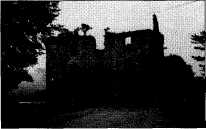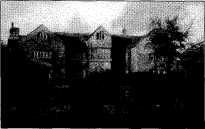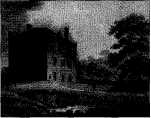| JOURNAL 1998 |
| North Craven Heritage Trust |
The Oxford Dictionary gives the following definition of "pele, peel, or piel":- "a palisade or fence formed of stakes; a stockade; either as the outer court of a castle, or as an independent fort or defensible position." There are references to peels from the thirteenth century. Later the term became the general one for small towers or fortified dwellings built in the sixteenth century in the border counties of England and Scotland for defence against hostile forays. A peel consisted of a massive square edifice, the ground-floor of which was vaulted, and used as a refuge for cattle, while the upper part (the access to which was by a door on the level of the first floor, with external ladder or movable stair) was the abode of the owner and his family. In this sense probably the name was short for peel-house, meaning a house defended by a peel i.e. a palisade or stockade.
In many cases there were later additions which often became incorporated into a large and important house such as Hammerton Hall, situated two miles from Slaidburn, Lawkland Hall, or Sizergh Castle in the Lake District. There is an excellent example of a tower undisguised by extra buildings at Hellifield.
Ogilvy's map, 1675, of the route from York to Lancaster marks Hellifield Pele and Lawkland Hall, the main road at that time passing directly adjacent to these important buildings. Hellifield and the next village eastwards, Coniston Cold, lie between the Rivers Ribble and Aire and Hellifield has the distinction of being on the railway link between Skipton and Settle. Its peel tower had been the main house of the Hammerton family, people of importance, who had by the end of the sixteenth century declined in fortune, partly a factor of stubborn recusancy. There were traditions of hides and underground passages associated with secret Catholic masses and fleeing priests but these are unsubstantiated. Hellifield Peel is at risk of decay because the leading was removed from the roof in the 1940's and it is now roofless, but still a fine example of a primary structure.
The Hammerton family of Hellifield owned a group of houses between York and Lancaster, one of which was Hammerton Hall. Its core is a peel tower and the house has a magnificent spiral staircase.
As far as Lawkland Hall is concerned it is easy to discern the original tower in the present elaborate building. It is possible that Austwick Hall is also constructed round a peel tower.
Further away but accessible in the summer is the peel tower of Sizergh Castle. The building is managed by the National Trust. Like Hammerton Hall's tower, access is by a narrow spiral staircase. It is not just the tower that is of interest at Sizergh, there are Elizabethan rooms full of portraits and panelling, and a fine afternoon could be spent in the gardens with their interesting shrubs and flowers.
On rural south Lancashire's skyline towers are a typical feature, some of them circular. Not far from Bolton, Turton Tower incorporates an ancient tower. Turton probably derives from Tower town or possibly, Thor town after the Norse mythical god. Although a structure may have existed on the commanding site since Norman times the peel dates from about 1400. The early structure would have been a defensive, rectangular tower with low doors and slit windows on three floors, linked by a spiral staircase. It was later developed as a house by the Orrell family with the additions of cruck framed buildings.
Peel, as a place name element, frequently implies a fortification. Thus Piel island, off the coast near Barrow in Furness was originally Fouldray, and owes its modern name to the Peel built at its southern tip. Peel Island on Lake Coniston is the site of a Norse stronghold.

J1998p10_19_files/tmpA57-1.jpg
"Hellifield in 1995" Photo: Maureen Ellis

J1998p10_19_files/tmpA57-2.jpg
Hammerton Hall Photo: Maureen Ellis

J1998p10_19_files/tmpA57-3.jpg
Hellifield Peel